*This article may contain product links which pay me a small commission if you make a purchase. Learn more.
Overhand throwing instruction in softball is very lacking, and this seems mostly due to the fact that pitching instruction is a different motion altogether. For softball players to throw harder, they need strategy and good instruction in their training.
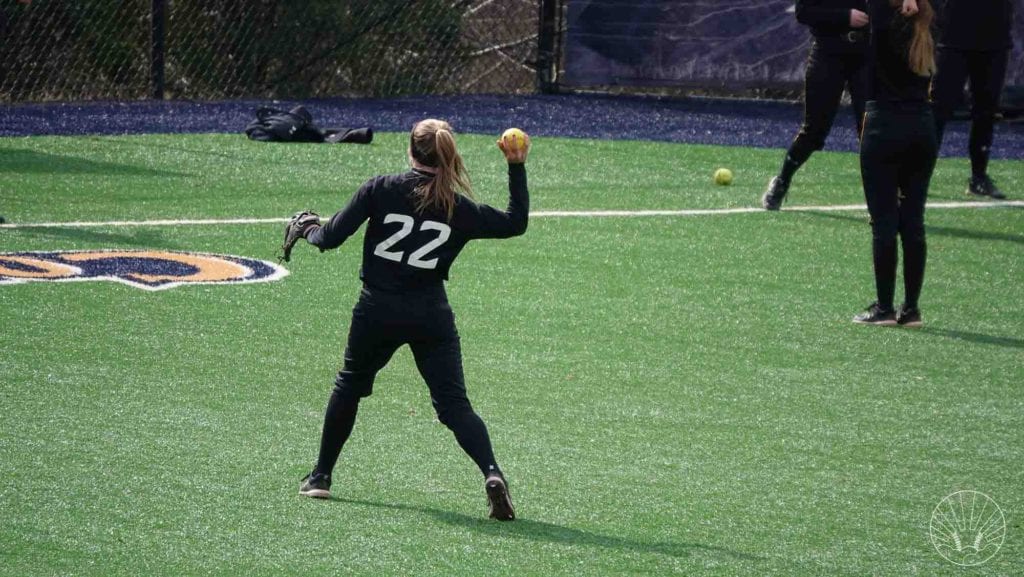
In baseball, young boys who learn to pitch also necessarily learn to throw properly; pitching = throwing.
But for girls who pitch underhand and throw overhand, there is a disconnect and overhand throwing lessons are rarely sought by parents. So, most fastpitch players never really focus on their overhand throwing mechanics, and this is why they don’t develop the skill well at early ages.
How Hard should a softball player be throwing?
First, let’s talk about how hard a softball player should be throwing for her age. Competitive fastpitch players need to throw about 55+ mph in order to get recruited to play college softball. Basic throwing skills are a huge necessity. Learn more about velocity by age in the video below.
What Factors Account For Throwing Velocity?
I made this video to help you understand what you should be doing as a player, or what you should be encouraging your players or daughter to do for training. This video is 12 minutes long and I HIGHLY encourage you to watch it.
Be sure to subscribe to my softball-only YouTube channel for more new videos!
Problem #1: Get The Elbow Up.
The low elbow is a common problem for softball players, but the issue is that it’s a symptom, not the cause of the problem.
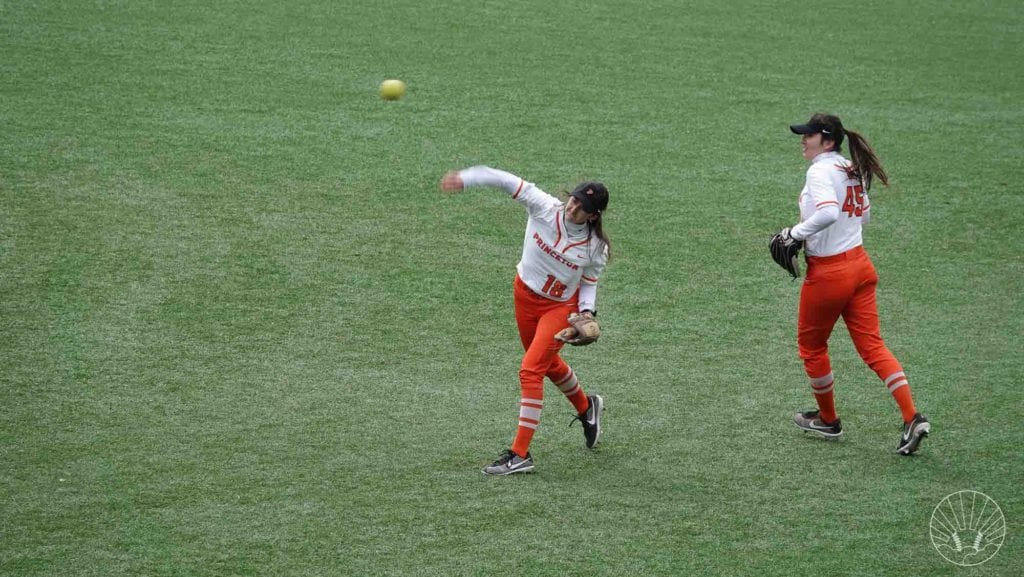
The most common flaw I see is a low elbow, and this is because girls are forced to throw a large, heavy ball.
With less relative strength than boys, it’s no wonder elbows drop. Converting a girl from a low-elbow thrower to a high-elbow thrower instantly adds 5-7 mph. This change never occurs “instantly,” however – it takes many months of concerted effort to fix, which is why most will not fix the problem without ongoing instruction and due diligence at home with drills.
Low Elbow = Lower Velocity Throws
The reason low-elbow throwing is so ineffective is part physics and part anatomy.
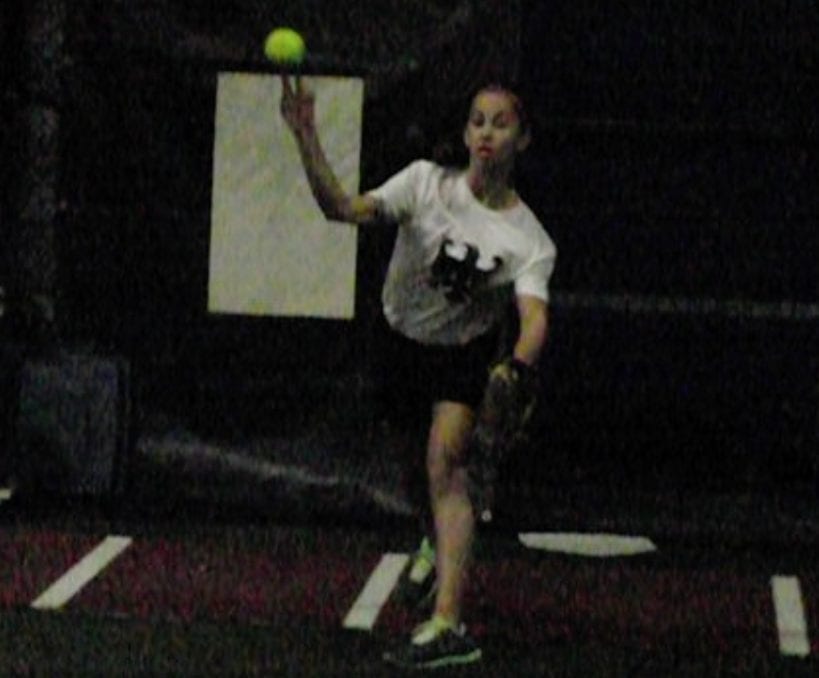
When the elbow is bent at release, the moment arm is shorter, resulting in less torque produced at the same velocity (and thus force applied to the ball).
Additionally, when the elbow is low the arm typically, but not always, adducts, making the final acceleration mostly a tricep-extension rather than internal rotation of the shoulder. We want internal rotation, which is the fastest human movement, rather than the must less explosive tricep extension.
Do This Drill to Help Improve a Low Elbow
The lawnmower drill helps improve a low elbow, as getting the front side to move more effectively is a big part in what the elbow does.
There’s no single drill that will be best for every player, but this one–the lawnmower drill–is very effective at teaching players how to pull their shoulder blades back, which can help improve the low elbow.
Factor #2. Funnel Ground Balls to the Center
Fielding technique is a MAJOR but underrated factor in how well a player throws. “Funneling” is a concept that’s important to master with daily drills that are easy to perform.
Basically, we want the ball to get vacuumed up to the center of the body after a ground ball in which the body is squared up to it. This makes for a great starting point for the rest of the throw, from which the arms will always have the same relative distance to move.
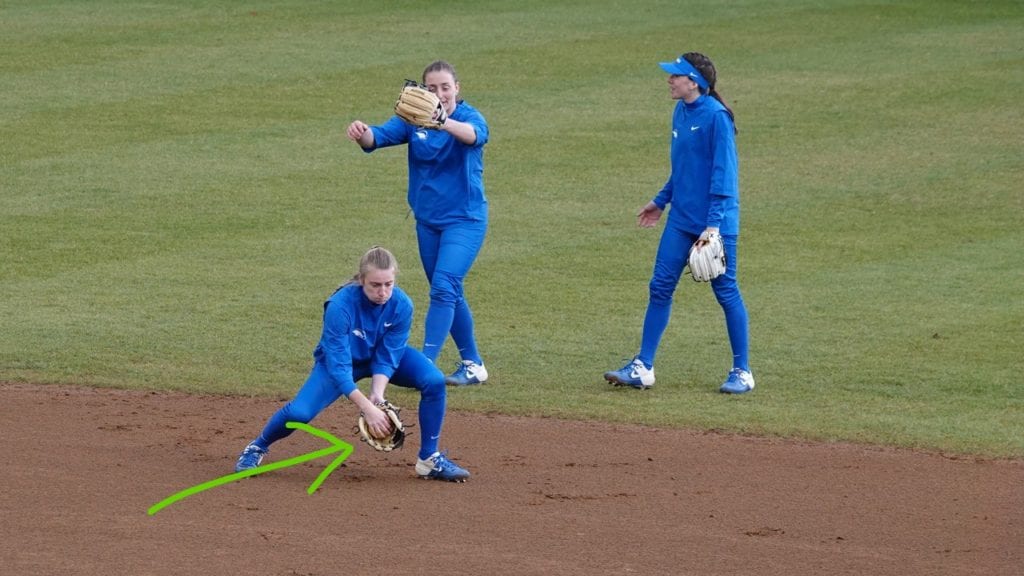
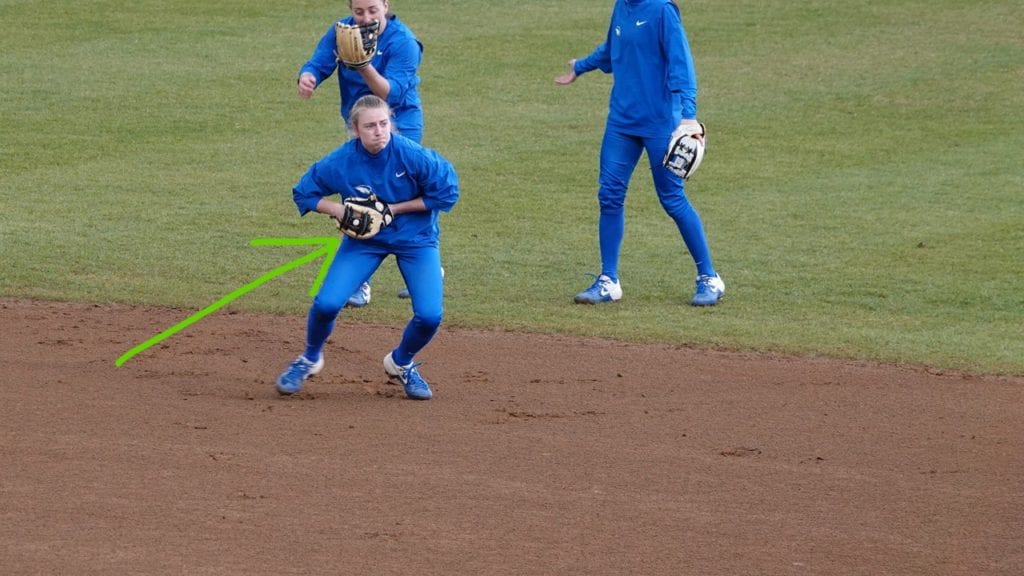
When the arms get into this consistent center position, the rest of the throwing motion is greatly simplified, and the distance each arm will move during the arm action will be shortened and simplified.
Recommended reading: Guide to Softball Positions.
Coaches should be drilling funnel technique on a daily basis, as it will improve velocity and accuracy across the board. When players start with the ball centered, they are more able to gather their weight, set their feet and make stronger throws with a better weight shift.
Takeaway? Good fielding is a precursor, a foundation for good throwing.
BONUS TIP: Improve Arm Strength with the External Rotations Exercise
The external shoulder rotators are crucial in helping to decelerate the arm.
Theraband CLX is a new version of the ribbon-like band many people have used in physical therapy. We use them with all of our academy’s teams and the players who train with us in my facility. I highly recommend them, and the red tension is probably the right starting point for young softball players, or green for girls 14 and up.
Just so you know – I do get a small commission if you use the links below at no additional cost to you. But, I only recommend products I use and believe in.
I recommend grabbing either a single Theraband CLX band [affiliate link] for yourself (about $12), or buying a roll for your team ends up being about $5 per band, but you’ll cut about 20 bands from a full roll, so you’ll have extras or could split with another team).
#3: Stride Farther And Use The Legs
Lateral hip strength is important for players to feel comfortable using their legs and really striding toward their target. Footwork and using the legs is critical no matter the position.
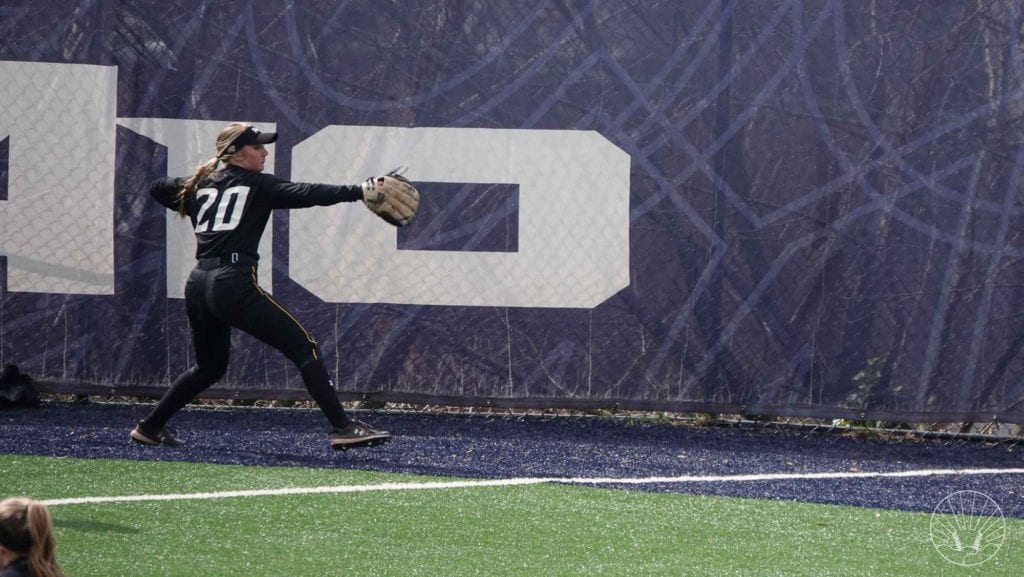
Athletes who are weak in their legs, most specifically in their glutes and lateral hips, tend to keep their legs beneath them more often. We see this time and time again, that weaker athletes have difficulty controlling their body in the air, at high speeds. The stride in a throw across the infield is an example – it’s an explosive lateral step that sends one leg pushing out in the air, forcing the body to stabilize on one, often weak, leg.
The farther and more dynamic the stride, the more forward momentum is produced and the more the hips and torso can help accelerate the arm. The softball throwing drill below is called the swing-shuffle, and it’s one of my favorites for teaching players how to use their legs.
#4: Mentally Let Go and REALLY Throw it.
As instructors, finding ways to increase throwing velocity is our way of advertising – everyone else notices it, and happy parents chatter about it. It’s too easy with most girls – we can add 1-3 miles per hour instantly, just by giving them radar gun feedback and showing them on video how timidly they throw.
“Finish” on a throw is crucial – we need to get 100% of our shoulder’s available acceleration on each throw and maximize hand and wrist involvement.
Much of the time, girls are leaving 2-3 miles per hour untapped simply because they ease off the throw and don’t finish it aggressively. This is FREE velocity.
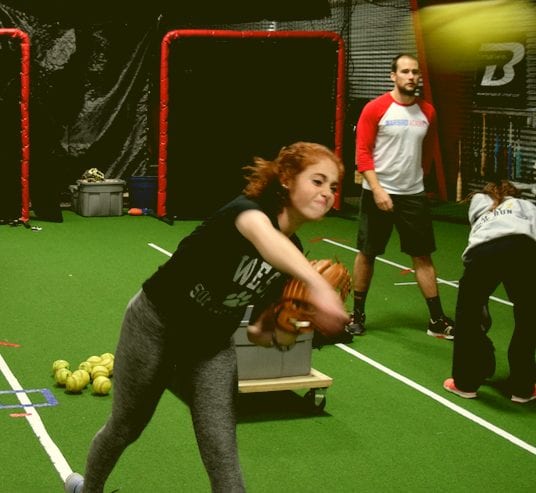
Most girls throw timidly, preventing full acceleration and leaving extra miles per hour unused.
Long toss is a great way to teach increased throwing intensity.
Throwing long teaches players to throw with more intensity, because to throw increasingly further distances, they have to reallllly finish each throw and pull down hard.
Again, we can usually instantly squeeze 1-3 miles per hour out of their arm without changing or strengthening anything. Long toss for softball can be an important tool to help fastpitch players throw with more intensity and increase their throwing speed.
#5: Learn To Use The Hips And Backside with Softball Throwing Drills
The hips are incredibly important in the throwing motion.
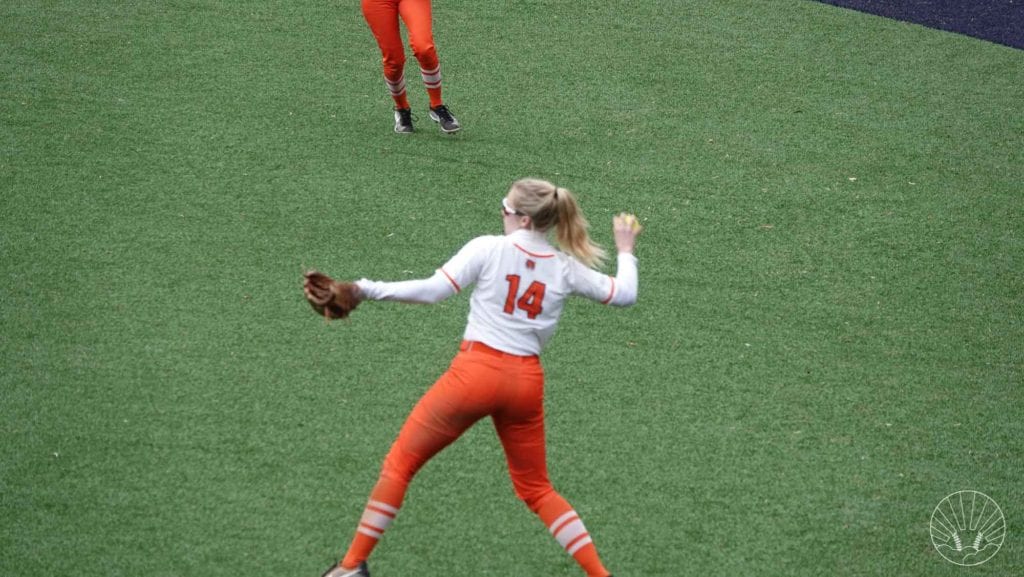
I see tons of softball players who have poor backsides in their throwing mechanics.
Back knees bending and lifting off the ground. We ideally want triple extension – ankle, knee and hip extended. This will not be as pronounced as with a baseball pitcher (because strides will be shorter), but it is still an important element when throwing as an infielder, outfielder or catcher.
We don’t want weak, forward-bending back legs – they prevent the chest and torso from pushing forward, increasing good leverage to aid in accelerating the arm. Good footwork is key and sets us up for a strong throw.
Softball Catcher Throwing Mechanics
The video below is an in-depth breakdown of four D-1 softball catchers. It shows their throwing mechanics, talks through key points, and also compares three high-level baseball players as well.
In all, you’ll see slow motion video of seven softball catchers. Check it out!
The throwing mechanics of a catcher aren’t much different from any other position player. But, they do take a lot of work to perfect, as catching is a fast-paced, high-stress position.
Keep Practicing and Develop a Consistent Routine
None of these fastpitch throwing tips above are complex – they simply require dedicated practice.
Almost all amateur softball players lack in 3 or more of the above areas, which means almost everyone has 5+ unused miles per hour lying dormant in her body.
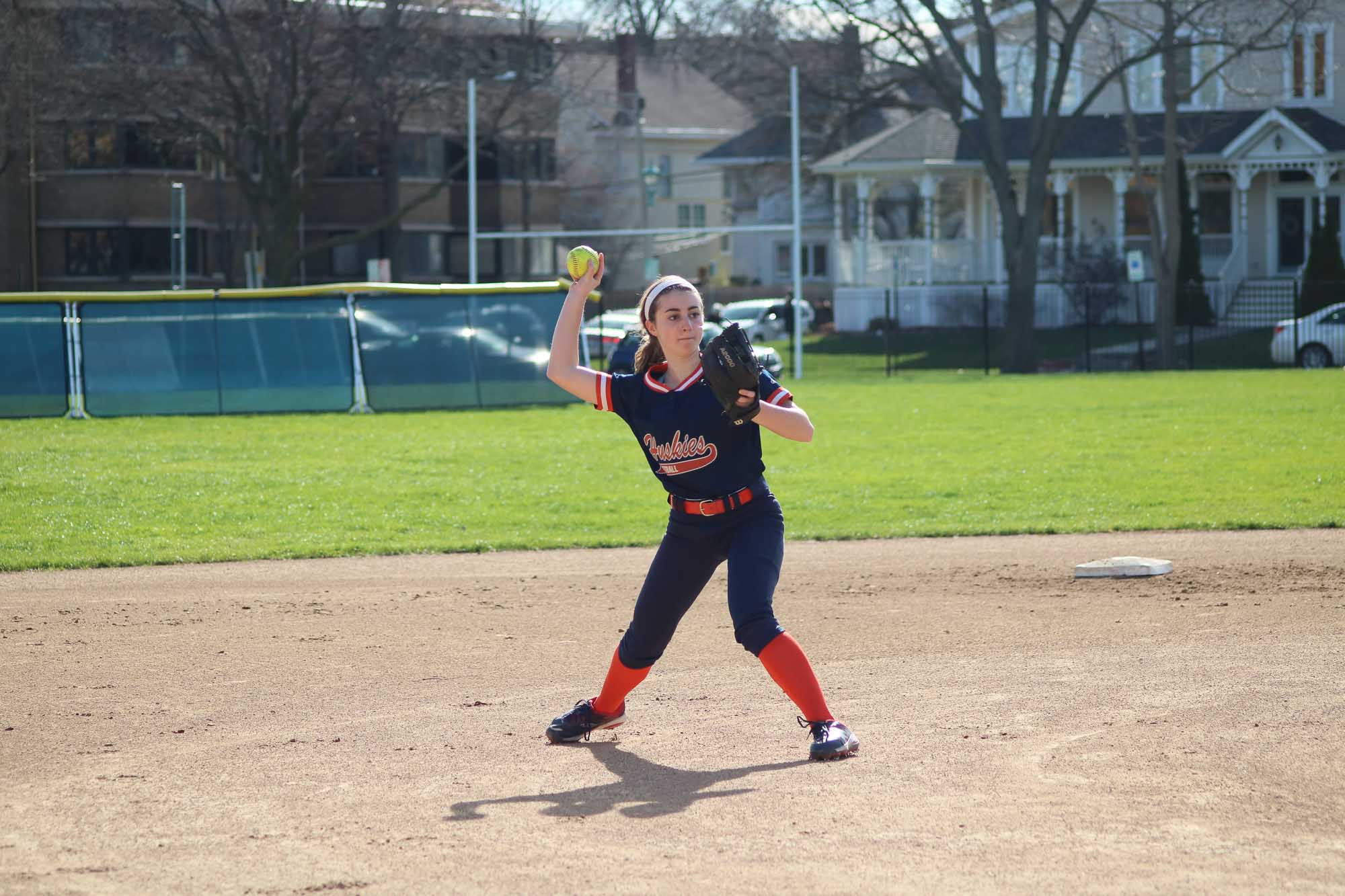
Cleaning up mechanics, improving strength and stability and learning to throw with intensity will all pay huge dividends. The right softball throwing drills will help tremendously.
I attended a 16U tryout a few years ago in which we got radar readings from 50 girls. The average throwing speed? 46-50 mph.
Three girls threw 54-57 and one threw 60-61mph – these were the top 8% of the group. We had three D-1 softball players in our Academy, all of which are heading off to college. Their average throwing velocity is 60-65 mph, and even in NJCAA softball, players need strong arms.
Read more on common softball throwing velocities here.
Need More? Check out this article I wrote on Softball Crow Hop Footwork.
Don’t Wait. Improve Your Throwing Today with My Help.
If you want to keep improving on your softball throwing mechanics, watch my free webinar and download my free throwing skills ebook.
Check it out below, as it shows you the drills, routines, arm strengthening and fielding routines you need to improve your throwing quickly.

Good luck this season! – Coach Dan
Softball Throwing FAQ
How do I improve my throwing in softball?
Step 1 is to work on your fielding technique, and be sure you “funnel” ground balls to your center when you’re square up to them. When the ball is at your center, your throwing mechanics will be more consistent. Step 2 is to make sure your elbow angle is correct (less than 90 degrees), you pinch your shoulder blades back, and you start your motion with your front side. Strength training is also very important, as bigger, stronger athletes typically throw much harder.
How fast can you throw a softball?
For women, the 99th percentile of throwing speed is 70mph, meaning very, very few women can throw a softball that hard. Elite players throw in the 64-68 range, with very good players throwing in the 60s. Any player can get to 60+mph with good form and hard work, but most amateur players 13-16 years old throw in the 47-52 mph, which is not good enough to play in college.
How do you throw harder?
You can’t be afraid to let it go–that’s step 1. Many softball players hold back, afraid to hurt their throwing partners or make an overthrow. Practice throwing harder if you want to throw hard. Long toss is a good tool, as throwing farther and farther challenges a player to really let it go, without fear of an overthrow or hurting anyone.
How do you make your throwing arm stronger?
“Arm care” exercises for the shoulder and rotator cuff muscles make a huge difference in throwing harder and feeling better. Many fastpitch players have arm pain, and a stronger shoulder will both help reduce pain, increase conditioning and throwing velocity. Lastly, strength training is very important for fastpitch players and should be a major part of any serious player’s routine.
How do you teach softball throwing mechanics?
Start with fielding–work on “funneling” technique, which means bringing the ball to the center on ground balls. Then, work on the hand break, which is when the throwing hand leaves the glove. Then, work on building momentum to the target–using a player’s legs is critical to gaining momentum, which is free throwing velocity. The more quickly a player moves toward her target, the faster she will throw. Many great drills for this can be found at www.snapsoftball.com
